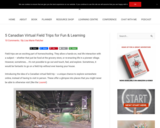
The virtual field trips on this site include:
The Parliament Buildings in Ottawa, Ontario
Iqaluit, Nunavut – The Canadian Arctic
Farm Tours
Canadian Museum of History
The Royal Tyrrell Museum

The virtual field trips on this site include:
The Parliament Buildings in Ottawa, Ontario
Iqaluit, Nunavut – The Canadian Arctic
Farm Tours
Canadian Museum of History
The Royal Tyrrell Museum
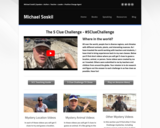
"All over the world, people live in diverse regions, and climates with different animals, plants, and interesting nuances. As I have traveled the world working with teachers and students, I have tried to bring experiences back to my own classes. Below you'll find short videos where you will get 5 clues to guess a location, animal, or person. Some videos were created by me as I traveled. Others were submitted to me by teachers and children from around the globe. Your mission is to do research and figure out the answer to each challenge in as few clues as possible. Have fun! "
Can you guess where he is?
Can you guess what animal it is?
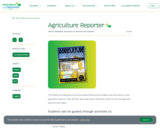
This resource puts students into the shoes of a new agriculture reporter. They will learn about agriculture while they search for the next big news story for their editor.
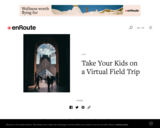
Curate your own exhibition at the Art Gallery of Ontario; swim with African penguins at the San Diego Zoo; travel back in time at the Louvre; visit the Canadian Museum of History; blast into outer space with NASA. This site offers all of these opportunities for your student to experience.

Discover all that the Meewasin Valley Authority with a variety of different options in programming from grades 3-6.
Grade 3 Ecology Programs – Northeast Swale
Explore Nature in the City! The Grade 3 Program at the Northeast Swale is a half-day of learning in a unique prairie wetland habitat. This program includes a nature hike in the ecological core of the Northeast Swale and features the exploration of ecosystem connections, identification of grassland plants and wildlife, nature mindfulness, and discussions of Indigenous Worldviews and treaty relationships as well as other place-based learnings.
These half-day programs (9:30 am – 11:30 am OR 12:30 pm – 2:30 pm) are offered in spring (May & June) and fall (September & October).
Grade 4/5/6 Ecology Programs – Beaver Creek Conservation Area
Beaver Creek Ecology programs include a full day of learning out in nature! You and your students will learn about and observe spring/fall migration, and mating and nesting behaviors of common birds at Beaver Creek with a special focus on the resident Black-capped Chickadee. This program also explores the impacts of weather systems on plants and animals, sustainable grassland management, medicinal plant uses, keystone species, predator-prey relationships, and the importance of citizen science.
These full-day programs (10:00 am – 2:30 pm) are offered each spring (April – June) and fall (September – November). We are grateful to SaskPower for their support of Meewasin’s educational programming.
Grade 4/5/6 Cross-Country Ski Program – Beaver Creek Conservation Area
In this full day program, students have an opportunity to feed the resident Black-capped Chickadees at Beaver Creek and to learn about winter adaptations, the importance of snow as habitat, and animal tracks on the open prairie. Students are introduced to cross-country skiing through a short lesson, followed by a 60 – 90 minute ski on the upland prairie with stunning views of the South Saskatchewan River Valley.
This ski trail is both fun and accessible for all skill levels! This full-day program (10:00 am – 2:30 pm) is offered in winter (January – March).

Through the activities within this toolkit, students will gain an understanding of the importance of nature and how all living things are connected. These resources are geared towards students in grades 6-8.
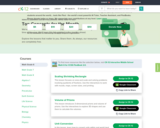
Excellent Interactive Lessons AND Assessments for All Levels of Math for Teachers and Students
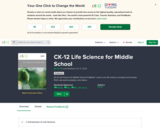
CK-12 Life Science for Middle School FlexBook® covers core life science concepts and includes real world examples, videos, and PLIX (which stands for Play, Learn, Interact, and eXplore—offers learners an interactive and immersive experience exploring concepts).
ck12.org
This is an extremely comprehensive unit on Diversity and Living Things. Some of the chapters are not aligned directly with grade 6 outcomes, but have the potential to be used for enrichment activities. In addition to what is listed above, this resource also includes online practice quizzes for students. Teachers can download printable versions of the quizzes, along with an answer key.
*You will have to sign up to ck12.org to access everything, but it is completely free!

This resource examines the biodiversity and the complexity of the various life forms that make up Canadian forests. The emphasis is on helping students appreciate the relationships and interdependence of all species in this ecosystem. Students learn how they can affect forests and understand ways to preserve and maintain their diversity. Themes include biotechnology, natural and introduced pests, species at risk, habitat loss and fragmentation, protected areas, climate change and traditional indigenous knowledge. Lessons can be summarized as follows:
Lesson One- It's What Inside That Counts ( 1x90min)
Students learn the basics of biodiversity by studying the arrangements of fauna and flora in a field investigation of the schoolyard. Teams will visit three assigned "habitat" sites and record living and non-living components. After discussing results, students are asked to create a poem or story about living in one of the habitat sites.
Lesson Two- Too Hot, Too Cold,...Just Right ( 2x45min)
This lesson focuses on how climate change impacts population numbers. After a discussion on how climate changes are driven by human activity, students are guided through a role play simulating the effects of rising temperatures on Arctic, Mid-latitude and Tropical biomes. After a wrap-up with discussion questions, students are asked to write a short story on an assigned topic.
Lesson Three- What Our Elders Say (1x60min, 1x90min)
After looking at how a Canadian Aboriginal legend relates to biodiversity, the students read and perform a play based on the "Legend of The Sky Sisters". Students then write their own legend incorporating an environmental message.
Lesson Four- Barrier To Biodiversity (2x60min)
After reviewing as a class how human activity can lead to habitat loss and fragmentation, students have to write and present stories in the form of a power point presentation, poster, public service announcement or skit describing how individual plants or animals are subject to, and respond to, stress in their habitat.
Lesson Five- Off Limits (4x45min)
Students investigate officially protected areas and create a class newspaper that contains articles which focus on the role of protected areas in helping maintain diversity. In this exercise they explore the social, economic, and environmental impacts of protected areas.
Lesson Six- To Be Or Not To Be (2x60min)
Students work in groups to produce a "species at risk" game board which focuses on the habitat impacts of: change/modification, over-exploitation of resources, poorly regulated commercial harvest, disruption of migration routes/breeding behaviors, contamination, and the introduction of exotic species.
Lesson Seven- Unwelcome Guests (2 x 60min)
Students develop a "Futures Wheel"(a graphic description of the inter-relationships and impacts of a single decision or event) focusing on exotic and invasive species in Canada.
Lesson Eight- Timberland ( 1x90min)
A role playing activity is used to show how biotechnology can be used as a tool to help maintain forest biodiversity. Using a timber-theft crime story students will complete a report (including a CSI sheet and victim profile) to assist them in understanding techniques used in biotechnology.
This resource can easily be adapted to include no technology.
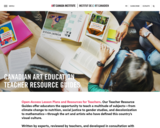
Canadian art is a door to learning about a wide range of subjects.
The Art Canada Institute teacher resource guides presented here offer students the opportunity to study a multitude of subjects—from environmental awareness to activism, social justice to gender studies, politics to computer science (to name a few)—through the art and artists who have defined this country’s visual culture.
Following our provinces’ education curricula, the teacher resource guides provide multidisciplinary learning activities that reveal how Canadian art powerfully reflects our world so we can better understand it.
Activities for K-12!

Canadian Geographic Education provides learning resources to help improve students’ understanding of the world they live in. Geographically literate students are better prepared to face global challenges and have the skills necessary to become effective change agents. Use these resources to inspire curiosity and exploration in your classroom!
Lesson plans
Videos
Maps
Infographics
Activities

Find tons of interesting animal facts!

This resource contains an abundance of ELA infused, cross-curricular lessons organized by themes for Grades 4, 5 and 6. Non-fiction, poetry and fiction reading lessons are all included.

An inquiry-based project to map the land in your community. The key concepts in this unit are grounded in Indigenous beliefs of interconnectedness, connectedness, and respect for all things.
The driving inquiry questions for this unit are:
1. How can respect for the land be shown?
2. What do we look for when setting up a camp?
3. What stories or teachings are connected to key locations in and around our community?
4. How has the land around our community changed over time?
5. Who do we share our community’s lands with?

iNaturalist is an identification key for plants, protist, fungi and animal species. It has online features as well as an app for Apple or Android, and is a joint initiative between California Academy of Sciences and the National Geographic Society.
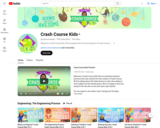
Crash Course Kids combines the same engaging lecture-style content delivery with animated graphics that focus on grade school science.
Topics include Earth Science, Physical Science, Biology, Geography, Engineering, and Astronomy.
These videos are amazing!
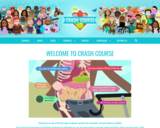
You can learn pretty much anything with these videos!
Science, History, Language Arts, & Study Skills, Games & More!

This site offers games, activities and resources in the following categories:
GAMES
MATH
LANG. ARTS
HISTORY
USA
GEOGRAPHY
SCIENCE
PEOPLE
HOLIDAYS
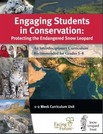
This unit consists of five lessons and is recommended for grades 5-8. The five lessons consist of:The Cat's Out of the Bag - students investigate the morphology, physical characteristics, and physical adaptations of four cat speciesMountain Mixer - students participate in a role playing, systems thinking activity to understand the relationships among species before constructing a food webIt Takes All Kinds of People - students participate in a town hall meeting in an effort to reach a concensus regarding conservation plansWhat's the Plan? - students explore the emerging issues through simulation activitiesTaking Action - students are led through a service-learning project of their choosing to raise money to donate*Planet earth videos referenced in the activities are available on YouTube.
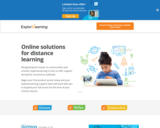
Explore Learning offers 3 programs to support students learning at home:
Gizmos (Grades 3-12) Get hands-on with math and science.
Gizmos are online simulations that excite curiosity and invite interaction. We’ve got over 400 Gizmos in our library covering topics and concepts in math and science for grades 3-12. Gizmos help students dig deeper into subjects and really understand challenging concepts.
Reflex (Grades 2-6) When they use Reflex, kids love math.
Adaptive and individualized, Reflex is the most effective system for mastering basic math facts in addition, subtraction, multiplication and division.
Full of games that students love, Reflex takes students at every level and helps them quickly gain math fact fluency and confidence. And educators and parents love the powerful reporting that allows them to monitor progress and celebrate success.
Science4Us (Grades K-2) It’s never too early to learn science!
Science4Us covers Inquiry, Physical Science, Life Science and Earth & Space Science with lessons specifically designed for K-2 students. The sessions have 1000’s of online and offline activities that can be completed in as little as ten minutes, and teach students using videos, interaction, poems, songs, and digital notebooks.